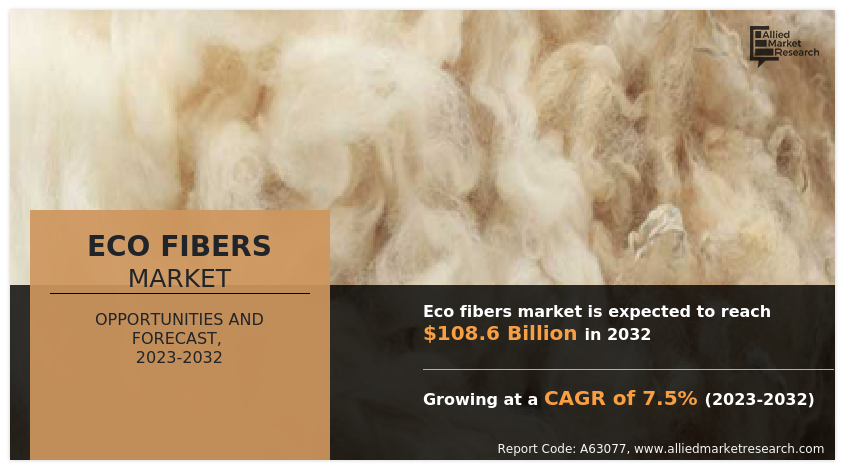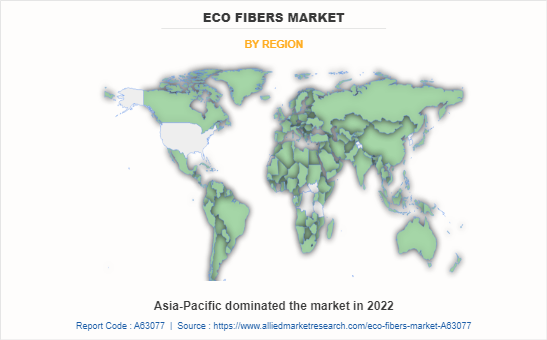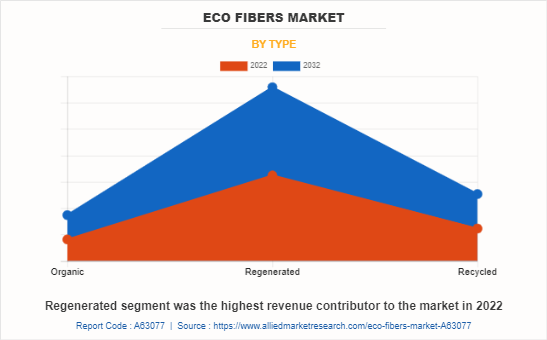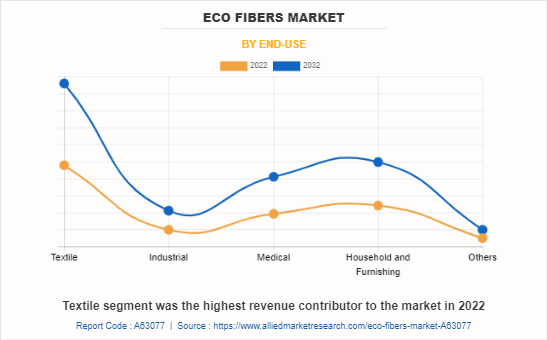Eco Fibers Market Research, 2032
The global eco fibers market size was valued at $52.8 billion in 2022, and is projected to reach $108.6 billion by 2032, growing at a CAGR of 7.5% from 2023 to 2032. Rise in consumer preference for green materials, driven by increase in awareness of environmental issues and sustainability, is significantly boosting the demand for eco fibers market. Consumers are actively seeking products made from natural, renewable, and recyclable materials, which are less harmful to the planet. This shift towards eco-friendly options is further fueled by innovation in bio-based fibers and alternatives, such as hemp, bamboo, and recycled materials, which offer sustainable solutions without compromising on quality or functionality.
Report Key Highlighters:
- The eco fibers market is highly fragmented, with several players including Grasim Industries Ltd; Teijin Limited; Lenzing AG; Shanghai Tenbro Bamboo Textile Co., Ltd.; Pilipinas Ecofiber Corporation; David C. Poole Company, Inc; China Bambro Textile Co., Ltd.; Sateri; Universal Fibers Inc.; and Tangshan Sanyou Group Xingda Chemical Fibre Co. Ltd.
- More than 6,765 product literatures, industry releases, annual reports, and other such documents of major industry participants along with authentic industry journals, trade associations' releases, and government websites have been reviewed for generating high-value industry insights.
- The study covers nearly 20 countries. The segment analysis of each country in terms of value and volume during the forecast period 2022-2032 is covered in the eco fibers market report.

Introduction
Eco fibers are sustainable, environmentally friendly fibers made from natural, renewable, or recycled materials that have minimal impact on the environment during production. These fibers are typically derived from plants, such as organic cotton, hemp, and bamboo, or from bio-based and recycled sources like Tencel (lyocell) and recycled polyester. Eco fibers are produced using environmentally conscious methods that reduce water usage, energy consumption, and harmful chemicals, making them an attractive alternative to conventional synthetic fibers in industries like textiles, fashion, and home goods. Their use supports the growing demand for sustainable, eco-friendly products.
Market Dynamics
Rising demand for eco fibers in applications such as textile, bedding, interior furnishings, paper and packaging, and automotive is driving the eco fibers market growth.
Eco fibers are commonly employed in the textile and apparel industry to produce accessories, clothing, and home textiles. These fibers can be blended with other fibers or utilized in their pure form to produce sustainable and eco-friendly fabrics.
Moreover, eco fibers are utilized in the production of upholstery, carpets, curtains, and rugs for homes, hotels, offices, and other spaces. They offer sustainable alternatives to conventional synthetic fibers, fostering healthier indoor air quality and decreasing environmental impact. Besides, eco fibers such as organic cotton, bamboo, and Tencel are widely used to produce pillowcases, bed sheets, duvet covers, and other bedding and linens. These fibers offer moisture-wicking properties and softness, delivering a comfortable and environmentally friendly sleep environment.
Furthermore, eco fibers, including recycled paper fibers, are used in the production of sustainable paper products and packaging materials. By utilizing eco fibers, the environmental impact of paper production can be minimized, conserving forests and reducing waste. Also, these are increasingly finding applications in the automotive sector. Fibers such as kenaf, hemp, and sisal can be used to produce lightweight and environmentally friendly materials for car interiors, seat covers, carpets, and insulation. However, the availability of cheaper substitutes such as nylon, polyester, acrylic, polypropylene, spandex or lycra, and rayon is likely to hinder the market growth. Nevertheless, innovation and technological advancement is anticipated to offer ample market growth in coming years. For instance, advances in eco fiber technology are enabling the development of functional and smart textiles.
By integrating sensors, electronics, and conductive materials into eco fibers, these textiles can have sensing capabilities, energy harvesting properties, or be used in wearable technology applications. Innovations in the integration of electronics and eco fibers are opening up new possibilities for smart fabrics. The eco fibers market is segmented on the basis of type, end-use, and region. By type, the market is categorized into organic, regenerated, and recycled. As per end-use, the market is divided into textile, industrial, medical, household & furnishing, and others. Region wise, the eco fibers market share is analyzed across North America, Europe, Asia-Pacific, and LAMEA.
Key players in the eco fibers industry include Grasim Industries Ltd; Teijin Limited; Lenzing AG; Shanghai Tenbro Bamboo Textile Co., Ltd.; Pilipinas Ecofiber Corporation; David C. Poole Company, Inc; China Bambro Textile Co., Ltd.; Sateri; Universal Fibers Inc.; and Tangshan Sanyou Group Xingda Chemical Fibre Co. Ltd.
Other players operating in the eco fibers market include Sustainable Fiber Technologies, Birla Cellulose, REPREVE, and others. Nowadays, the key manufacturers operating in the eco fibers market have been engaged in strategies such as product innovation, joint venture, expansion, partnership, agreement, investment, and collaboration.

Asia-Pacific dominated the market in 2022. Asia-Pacific is a primary hub for textile production and consumption, making it a vital region for the eco fibers market. The region has a growing textile industry, with countries including China, and India being major textile producers. Besides, various countries in the region are implementing policies and regulations to encourage sustainable practices in the textile industry. Governments offer incentives and support for eco fiber production, promoting manufacturers to adopt sustainable alternatives.
Furthermore, there is a growing consciousness among consumers in the region regarding sustainable fashion and eco-friendly products. Consumers are widely demanding garments produced from eco fibers, driving brands and manufacturers to integrate sustainable fibers in their product lines. The rising consumer awareness about the environmental impact of textiles coupled with the growing demand for sustainable and ethically produced fibers has been bolstering the adoption of eco fibers in the region.

Regenerated segment was the highest revenue contributor to the market in 2022. Regenerated eco fibers are sustainable textile materials produced through the regeneration of existing materials. These fibers are typically derived from waste materials or by-products from various industries and transformed into usable fibers. They offer environmental benefits by reducing waste, conserving resources, and minimizing the need for virgin materials.
Regenerated eco fibers help conserve natural resources by utilizing waste materials or by-products from various industries. The focus on resource efficiency and circular economy principles drives the growth of man-made regenerated eco fibers.
Furthermore, government support through incentives, grants, or regulations can drive the adoption of regenerated eco fibers. Policies promoting recycling, waste reduction, and sustainable textile production encourage businesses to explore eco-friendly alternatives such as regenerated fibers. Government initiatives play a crucial role in creating an enabling environment for the growth of regenerated eco fibers.

Textile segment was the highest revenue contributor to the market in 2022. The textile industry is one of the major contributors to environmental pollution, including water pollution, chemical usage, and waste generation. In order to address these issues, textile manufacturers are embracing eco fibers as a way to minimize the environmental footprint. By utilizing these fibers, which are produced sustainably, they can minimize the negative influence on ecosystems and natural resources.
Furthermore, governments and regulatory bodies are implementing stricter environmental regulations and standards for the textile industry. This includes requirements for reducing water and energy consumption, waste generation, and the use of harmful chemicals. Eco fibers often comply with these regulations, making them a preferred choice for manufacturers. In addition, technological advancements have made it easier and more cost-effective to manufacture and process eco fibers. Production techniques such as solvent spinning, enzymatic processing, and mechanical recycling have improved, enabling the manufacturing of high-quality eco fibers at a larger scale. These advancements in technology have facilitated the integration of eco fibers into the textile industry.
Key Benefits For Stakeholders
- This report provides a quantitative analysis of the market segments, current trends, estimations, and dynamics of the eco fibers market analysis from 2022 to 2032 to identify the prevailing eco fibers market opportunities.
- The market research is offered along with information related to key drivers, restraints, and opportunities.
- Porter's five forces analysis highlights the potency of buyers and suppliers to enable stakeholders make profit-oriented business decisions and strengthen their supplier-buyer network.
- In-depth analysis of the eco fibers market segmentation assists to determine the prevailing market opportunities.
- Major countries in each region are mapped according to their revenue contribution to the global market.
- Market player positioning facilitates benchmarking and provides a clear understanding of the present position of the market players.
- The report includes the analysis of the regional as well as global eco fibers market trends, key players, market segments, application areas, and market growth strategies.
Eco Fibers Market Report Highlights
| Aspects | Details |
| Market Size By 2032 | USD 108.6 billion |
| Growth Rate | CAGR of 7.5% |
| Forecast period | 2022 - 2032 |
| Report Pages | 287 |
| By Type |
|
| By End-use |
|
| By Region |
|
| Key Market Players | Pilipinas Ecofiber Corporation, Grasim Industries Ltd., David C. Poole Company, Inc., TEIJIN LIMITED, Universal Fibers Inc., China Bambro Textile Co., Ltd., Sateri, Tangshan Sanyou Group Xingda Chemical Fibre Co. Ltd, Shanghai Tenbro Bamboo Textile Co., Ltd., Lenzing AG |
Analyst Review
According to the opinions of various CXOs of leading companies, the eco fibers market is expected to witness increased demand during the forecast period due to surge in awareness of environmental issues, such as climate change, pollution, and resource depletion, which has led to a rise in consumer and industry demand for sustainable and eco-friendly products.
Moreover, advanced processing techniques are being developed to improve the efficiency and sustainability of eco fiber production. For example, innovative spinning methods, such as air-jet spinning or electrospinning, are being explored to enhance the quality and properties of eco fibers while reducing energy consumption and waste. Besides, bioengineering and biomimicry approaches are being used to develop eco fibers inspired by natural systems and structures. By studying the characteristics of materials found in nature, researchers are designing fibers that replicate desirable properties, such as strength, flexibility, and self-healing capabilities, using sustainable and renewable materials.
Further, advances in eco fiber technology are enabling the development of functional and smart textiles. For instance, eco fibers can be engineered to have moisture-wicking, temperature-regulating, or odor-controlling properties. Integration of sensors, electronics, and conductive materials into eco fibers is also being explored for applications in wearable technology and smart fabrics. Also, research is focused on improving the performance attributes of eco fibers, such as strength, abrasion resistance, moisture management, and dyeability. By optimizing fiber structures, surface treatments, or chemical modifications, eco fibers can compete with conventional synthetic fibers in terms of performance while maintaining their sustainable characteristics.
The global eco fibers market was valued at $52.8 billion in 2022, and is projected to reach $108.6 billion by 2032, growing at a CAGR of 7.5% from 2023 to 2032.
Textile is the leading application of Eco Fibers Market.
Asia-Pacific is the largest regional market for eco fibers.
Growing demand for eco fibers in applications such as textile, bedding, interior furnishings, paper and packaging, and automotive is driving the eco fibers market growth.
The top companies to hold the market share in eco fibers include Grasim Industries Ltd; Teijin Limited; Lenzing AG; Shanghai Tenbro Bamboo Textile Co.,Ltd.; Pilipinas Ecofiber Corporation; David C. Poole Company, Inc; China Bambro Textile Co., Ltd.; Sateri; Universal Fibers Inc.; and Tangshan Sanyou Group Xingda Chemical Fibre Co.Ltd.
Loading Table Of Content...
Loading Research Methodology...



